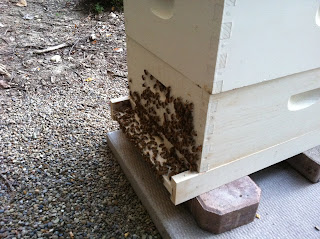There is nothing like going to the spa to keep the girls happy. I often see bees sipping at our bird baths (which they think they are bee baths) and various puddles around the yard, but on Saturday, I witnessed something unusual. There were bees, lots of bees, at the metal birdbath and none at the two stone birdbaths on either side of it. At one point I counted 14 of the girls in there, drinking, grooming and even swimming. And the frolicking went on all day. And Sunday, they were back for more! When the foraging bee found the bird/bee bath on Saturday, she must have returned to the hive and made a very specific bee dance indicating water at the exact location of the metal, but not the stone, vessals.

There are eight bees in the above picture. At the 9 o'clock position, there are two bees grooming each other. I can only guess what was going on there, perhaps something like this.
On Friday, I tended to the hives. It took me an hour and 15 minutes to tear down the hives, make hasty inspections, replace pollen patties, dust the bees with powdered sugar (the 3rd and final treatment for varroa mites) and fill the hive top feeders with sticky syrup. Once again, I saved the cranky girls in Hive 3 for last. While I was working on their hive, I gave them liberal amounts of smoke and cooed to them about how calm they were and what good bees they are, storing honey for winter and staying on their best behavior. I transported about three gallons of syrup in a clean, white bucket, taking care to keep it covered with a carpet scrap to discourage robbing and to keep the bees away from the motherlode of easy eating, right from the bucket. An uncovered bucket full of syrup near the hives would be like delivering 100 pizzas to a school right before lunch.
After I was finished with the feeding, as I collected up my paraphernalia, I saw that several bees had gathered in the bucket to collect the remaining sticky droplets. I carried the bucket closer to the house, but outside the range of Sam the Doodle's invisible fence. I knew that if I brought the bucket to the garage, I'd have bees in the garage, and if the bucket were inside of Sam's territory, he would hunt the bees, resulting in a bad outcome for both insects and canine. I turned the bucket on its side so I could see into it and for the remainder of the day bees (and yellow jackets) collected in there. After dark, I took a closer look. There were still honeybees in the bucket. Frankly, they didn't look too good. I had sifted about four pounds of sugar into the hives and the girls were well-coated. When they went into the bucket the syrup droplets got on them too, and I think they were becoming candied bees. There was a lot of grooming going on in that bucket. Bees continued to scour the bucket on Sunday. By late Sunday afternoon, I saw no bees in the bucket so I picked it up to wash it and put it away until the next feeding. Washing was really unnecessary, as the inside of the bucket was 100% unsticky. I was amazed at how thorough they were in getting every last bit of sweetness.
Is it a coincidence that at the same time the girls were hot tubbing? I think there's a correlation here.
Here are some more observations from the beeyard this past weekend.
- Because I don't make the same mistakes twice, I took Benadryl before I went out to tend the bees.
- Even on pleasant fall days, I steam inside my protective suit. By the time I collect my gear and hustle back to the garage, I am breathing hard and feeling soggy.
- Between the drugs and the stress of staying focused and trying not to make mistakes that result in stings, after I come inside, I shed the suit and plotz, safe but spent. Really, this takes the stuffing right out of me. Every time.
- Watching a honeybee hover two inches above a bird bath, I can see the water ripple from her wings. It's not like she made whitecaps, but how fascinating that she moves so much air that I can see it on the surface of the water!
I am delighted to report that this week I beat the reaper. I took care of my bees and my advanced human brain out-thought 150,000+ itty bitty bee brains. The sting count remains at 13.





















